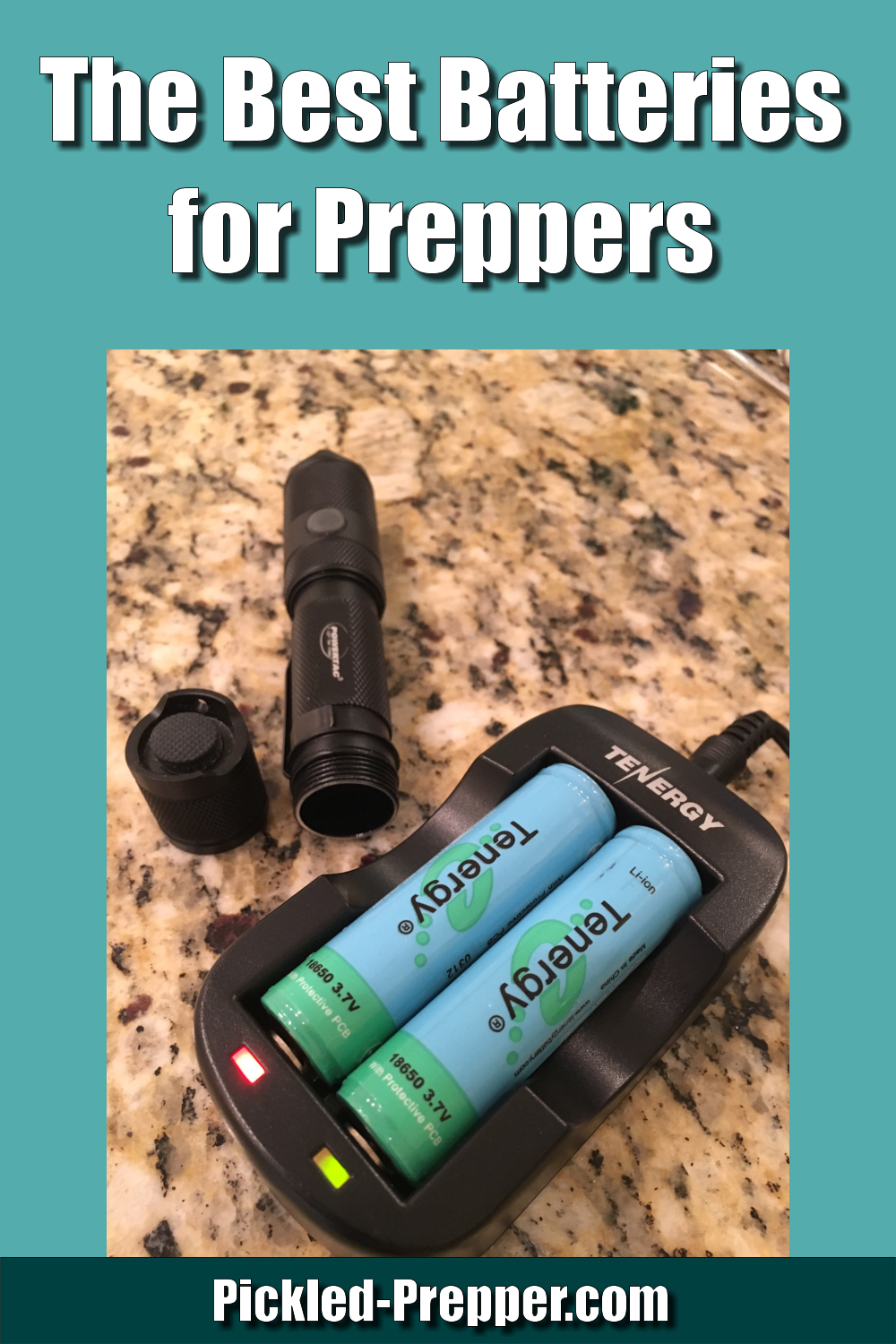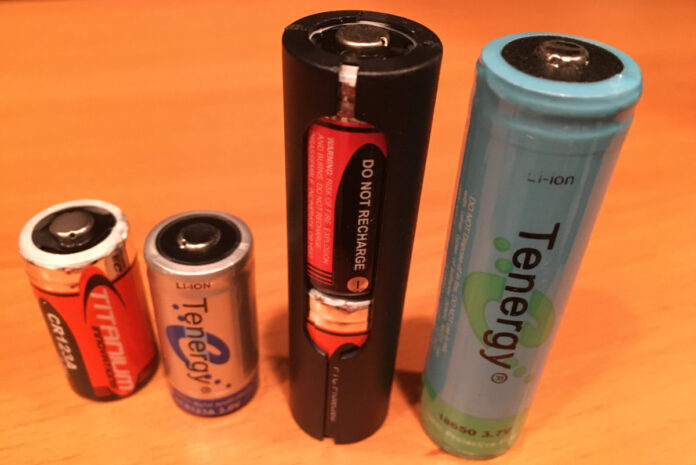
The Sixth B: Batteries
If you’re a prepper, you’ve probably heard about the five Bs: Beans, bullets, Band-Aids, bullion, and the Bible. This is useful, short-hand way of reminding you that to prepare, you need food, self-defense, first aid, a way to preserve your wealth, and to protect your soul.
I’d like to propose an additional B to this traditional list: Batteries. Because in a TEOTWAWKI scenario, electrical power will be the only thinking keeping us clinging to the modern world instead of slipping back to the dark ages. If you doubt this, just ask home owners in California what it’s like when PSE&G shut off power to help prevent wild fires. Or asked Venezuelans what it’s like to have rolling black outs. Talk to someone in an apartment building with an elevator, or on a rural property where their water supply requires an electrical pump, and see how their life changes when there is no power.
When power fails – either locally or on a regional or wider basis – there is a cascading effect that results in a loss of refrigeration, communication, transportation, computation, lighting, and modern entertainment. Should the power outage last long enough, there are often subsequent losses of other utilities, such as water pressure, sewage processing, and natural gas. Yes, even those on municipal water and sewage systems may be affected as pumps cease working and system pressure drops.
The obvious way to eliminate many of the downsides resulting from the loss of grid power is to not be reliant on grid power in the first place, meaning you have your own solar, wind, hydro or other power generation system in place with a large bank of batteries to store power. A less useful alternative, but none the less useful in short term outages, is a generator that powers a number of critical; electrical circuits in your home. The downside of generation in a long term outage is the limited supply of fuel.
Battery Powered Devices
If you have neither of these options, then you will be dependent on batteries for your electrical needs. While batteries cannot replace the grid, they can address a number of issues. Here are a few battery powered items that you may need during a power outage:
- Flashlights, head lamps, and lanterns to light up the room or a task and allow us to work after dark, walk around with bumping into things, see who is approaching, and possibly to signal each other Paul Revere style. Unlike flame-drive light sources used by our ancestors, battery powered lights are instant on and off, require no fumbling with matches and can be safely used by children. Battery-powered lights won’t burn down the house if knocked over and don’t generate carbon monoxide, making them safer than candles, kerosene or Coleman lanterns. (Don’t get me wrong: Because I take a layered approach to prepping, I have candles, kerosene lanterns and dual fuel lanterns, but I prefer flashlights for convenience, brightness, and safety.) We have an entire article dedicated to LEDs that provides more information on flashlights.
- Phones, which allow us to stay in touch with friends and family, call for aid, and communicate with people. They also allows us to access news and information services as long as the cell network is up, and entertain ourselves or our children via games and videos. (If you have a land line, remember to have at least one hard-wired phone that does not require electricity.)
- Radios, useful for accessing national and local news and information (AM/FM), for entertainment, and for communicating with others (CB, HAM, FRS, etc.)
- Medical Equipment. Some people may have specialized medical equipment that runs on batteries or use back up batteries. This could be as simple as a hearing aid or a CPAP machine, or as complex as an oxygen generator or other life-saving device. If you or a loved one depends on such a device, you definitely want to stock some back up batteries.
- Tools, such as powered drills, saws, chainsaws, water pumps, etc. After a natural disaster, you may need your tools to make repairs, clear fallen trees, etc.
Optics. If you have night vision, a scope with a lighted reticle, a laser, or a white light, batteries will enhance your ability to protect yourself and your castle in a grid-down situation. - Computers have limited value in a long-term disaster if there is no internet access. Their primary use is as a virtual library. You can use them to access PDF, eBooks, and other stored documents such as how-to books, instruction manuals, medical resources, etc. They may also have some value for entertainment purposes. Laptops can run on batteries, at least for a several hours.
Out of all of these useful battery powered devices, I’m going to pay special attention to flashlights because of their universal value. If you only buy one battery powered emergency device, but a good tactical flashlight.
Flashlights
Unless you rely on specialized battery-powered medical equipment, flashlights are going to be the most important battery powered device in a disaster situation, if only because it’s dark half the time. And while probably every home has a generic flashlight or two trucked into a drawer, I recommend you upgrade to high-powered tactical lights. Why tactical? Because they are robust. They are usually drop proof, water proof to some degree, and won’t burn out or cease working. The following types of battery powered lights are listed in order of priority, meaning the first is the most important:
- A hand-held flashlight small enough to be carried in a pocket or purse. This should be part of your everyday carry. And by using it regularly, you’ll know it’s reliable and ready. Ideally, this will have several brightness levels. (See our recommendations, below, for brands.)
- A headlamp with adjustable brightness that can be dimmed to a point where you can easily read or brightened to a point where allows you to do outside work or chores in the middle of the night. Alternately, you can have two headlamps – a dim model for inside use and a brighter one for outside use.
- A work light or lantern that can be mounted, hung or set rather than carried about, and is designed to light a task or a room. Like the headlamp, it frees your hands. For example, when you are making dinner, you might wear a headlamp. When four of you are eating dinner at a communal table, a lantern will be more efficient.
- A weapon light that can be mounted on a pistol or a long gun. Most will have a momentary switch so you can pop the light on long enough to acquire and identify your target but shut it off before you draw too much in-coming fire. These can be tactical lights with weapon-mount kits of mission-specific lights such as the Streamlight TLR1.
- A setting-specific light. This might be a light you keep in your car, a flashlight light by the door to see why the dog is barking, or a lantern you keep in the barn or basement. In my house, these are the oldest lights, the old Maglites that run on D or C cells, that we keep on hand, “just in case.”
- Outdoor security lights. Featuring a combination of bright LEDs, solar panels, motion detectors, and built-in batteries, solar powered exterior security lights can act as a deterrent and provide an enhanced degree of safety during a power outage. They can also alert you when there is movement outside
When it comes to flashlights, remember the prepper adage: one is none and two is one. Have more than one per person and keep any old tactical lights in an ammo can for safe keeping – you never know when you may need a back up or to lend it to someone else.
Batteries
Just like I recommend that you limit your survival armory to some common calibers, I recommend that you limit your batteries to a few specific types. Here’s what I store and why:
18650s
If we had to select the single best battery for preppers, it would be this rechargeable lithium battery that usually stores anywhere from 2,600 to 3,400 miliamp hours (mAh) of energy. (Don’t believe claims that an 18650 has 5,000 or 6,000 mAh of storage – my testing has shown this is just not true.) Unlike common alkaline batteries that provide 1.5 volts, these are usually 3.6 or 3.7.
Although you may have never heard of a an 18650, they use common cells that power a good many rechargeable kids toys and electronics, as well as some electric cars. This is probably the most powerful battery you can obtain for easily portable devices. (The 26650 is a fatter version of the battery used in some very powerful flashlights, but is heavier and far less common.)
Last year, when we were prepping for Hurricane season, I took out all my 18650 batteries to charge them up. I was shocked to find that I own 18 of these powerful cells. All of my tactical flashlights can run on 18650s.
Many newer flashlights and other devices that use one or more 18650 cells can be plugged into a USB port to charge their 18650s, but you can also get exterior chargers that can charge two or four at one time. I ahve also seen an 18650 that can have a USB cord plugged directly into it, so no exterior charger required.
Some 18650 batteries are rated HD, or high discharge. These are used in the newest generation of very bright tactical lights, meaning small, hand-held lights that generate 2,000 or more lumens. You can use and HD 18650 in any device, but devices built for HD batteries require the HD model.
Pro Tip: Buy brand names like Tenergy or Titanium or those made by a good flashlight company. I avoid brands like UtraFire and TrustFire because I have found them to be inferior and they exaggerate power claims. See the list of brands I rely on, below.
CR123s
Originally used for cameras and photography flashes, these powerful little lithium batteries helped Surefire create the tactical flashlight market by providing the higher voltage required to produce more light than the standard 2-cell C or D battery powered light in a much smaller package. I buy these in 50-packs and they have a 10 year shelf life.
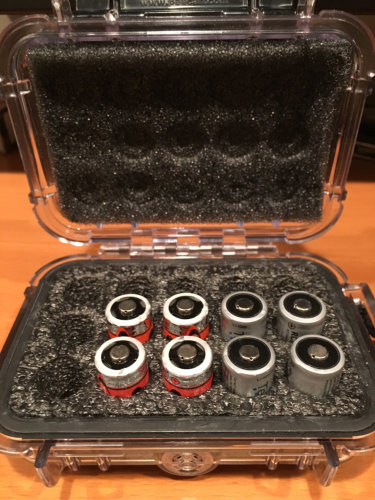
Many early tactical flashlight used two CR123s. A generation or two later, the lights were made with a slightly larger diameter body which allowed them to use either two CR123s or one 18650. To this day, I keep two CR123s in my weapons-mounted lights because we may go years without using them and I believe the CR123s will have a longer shelf than an 18650 which may slowly discharge over time.
I stock primary CR123s, which is to say batteries that are not rechargeable. I use these in optics like the Eotech XPS series. We do have some rechargeable RCR123s on hand for emergency backup, should all the normal ones are used up, but I don’t like to rely on them because they provide a much lower run time. The primary CR123 has twice the mAh as the rechargeable.
CR2025 and Coin Cells
These lithium batteries are a little smaller than a quarter and have become surprisingly common over the past decade. My primary use for them is in small, compact red dot sights and other optics. Multiple scopes with illuminated reticles use them. Their chief advantage is their small size, followed by their low cost. (Buy them in strips of 5 or packs of 25 to get the best savings.) If you have a rifle optic that uses them, store a spare battery or two in the pistol grip storage compartment of you AR-15 grip.
I own a charger and rechargeable RCR2025 cells and LI2032, but they are not usually seen in stores. You’ll need to look online.
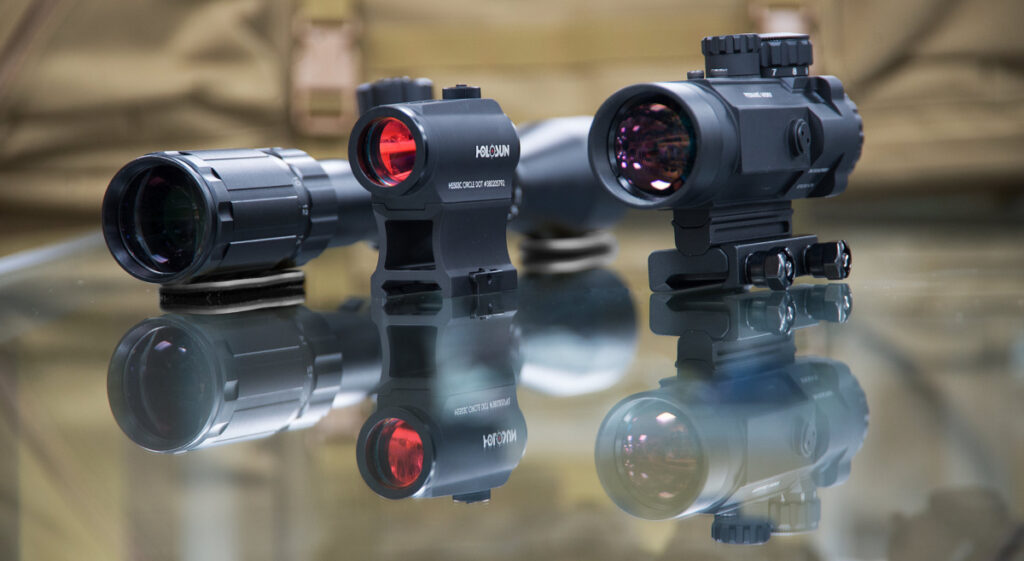
AAs and AAAs
These are not my first choice, but they are so common that you really have to use them and store spares. For example, small portable radios usually use AA or AAA batteries, as do many cheap headlamps and consumer-oriented LED flashlights. More importantly, my night vision goggles require AAs, and I have two optics that use them, including an old Aimpoint Comp 4.
Traditional AA and AAA batteries are alkaline. I recommend that you upgrade to lithium AAs for any expensive or mission-critical devices, like night vision and optics. Lithium cells will not corrode and ruin your device, work better in cold weather, and provide longer run times.
There are plenty of rechargeables out there in multiple formulations from a variety of companies. Avoid the older NiCad and go with Ni-MH or better. I own Eneloop batteries and a friend has recommend the Amazon Basics brand, which are significantly cheaper.
About the only advantage I can see of using AA and AAA batteries is that in a post-TEOTWAWKI situation, you could go into any abandoned house and probably find a dozen batteries simply by opening various remote control devices. Compared to CR123s and 18650s, they are low powered.
C and D Cells, 9 Volts and 6 Volt Dry Cells
These are like the Windows XP of the battery world: We may remember them fondly but we try not to use them. There are a few old camping lanterns and a couple Maglites kicking around our compound that require C or D cells, but we don’t count on them for anything really important.
In my opinion, anything that requires two or three D cells for would be better off using a single 18650. Look around when you buy your electronics and you may find one that is rechargeable.
How to Recharge in a Grid Down Situation
We’ve talked quite a bit about rechargeable batteries, but what do you do when they need a recharge? Solar power is your best bet and will be the topic of a future article. You can buy a 100 amp solar power set up for around $150 that will charge dozens of batteries per day of sunlight. Smaller, portable solar panels can be used in the field to charge a couple batteries at a time and can often offer USB outputs.
Solar charging is also excellent for cell phones, tablets, and other devices that do not have user-replaceable batteries.
If you run a generator during a short term emergency, you can obviously charge them with generator power – just use a power strip to ensure you have enough available outlets to plug in multiple charges at one time so you are not wasting power. Generators should be run sparingly and for short periods of time during an emergency – not 24 hours per day. If you need to power a refrigerator or freezer, I recommend three or four hours in the morning and again at night.
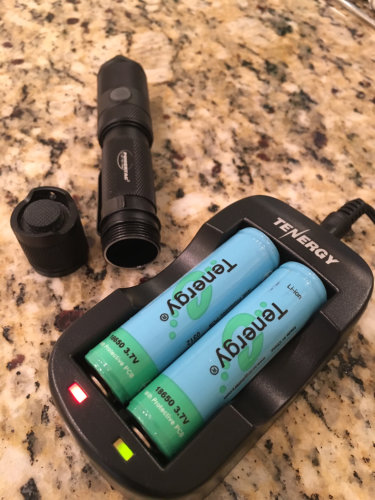
Use Caution Charging Lithium Batteries
You May have all heard about cell phone or laptop batteries that have spontaneously combusted. Then there are the hover boards that caught fire, and just Google “Tesla fires” for some scary reading. The fact is, lithium batteries can cause a fire if used improperly. For safe handling, read and follow the manufacturer’s instructions on all batteries, devices and chargers. Do not attempt to recharge non-rechargeable batteries and do not cut open or disassemble batteries.
When you use 18650s, RCR123s or any other rechargeable lithium battery, make sure you only buy a batteries with protection built in. This usually means protection against overcharging and rapid discharging which can cause the batteries to overheat. The charger should also include circuitry to prevent over charging.
Even with this protection built in, I always put my charger on a non-flammable surface when I charge my batteries, just to be safe. I also check on the charger from time to time and remove batteries as soon as they have reached their full charge.
Fight the Dark
In a power outage or other grid down situation, flashlights and batteries will be your friend. Don’t skimp on either. Buy well-known, proven brands designed for tactical or other hard-duty use. If you can only afford cheap products direct from China or brands you’ve never heard of, then test them beforehand to ensure they meet your expectations. This will decrease the odds of Mr. Murphy showing up at the worst time.
Here are brands I have used and recommend:
Flashlights:
- Fenix
- NiteCore
- PowerTac
- Streamlight
- SureFire
- Duracell
- Energizer
- Panasonic/Eneloop
- PowerTac
- Streamlight
- Surefire
- Tenergy
- Titanium
Chargers:
- NiteCore (they have a range, but their digital cahrgers are the best)
- PowerTac
- Tenergy
There may be plenty of other brands out there that will get the job done; I just haven’t used them myself.
Editors note: Yes, we know there are other sizes and formats of batteries out there that are useful in a power outage or grid-down situation, including golf cart batteries, deep cycle marines batteries, lithium power packs and batteries intended for use in solar systems. This article is focused on batteries for portable devices, however we’ll cover other batteries in the future.
